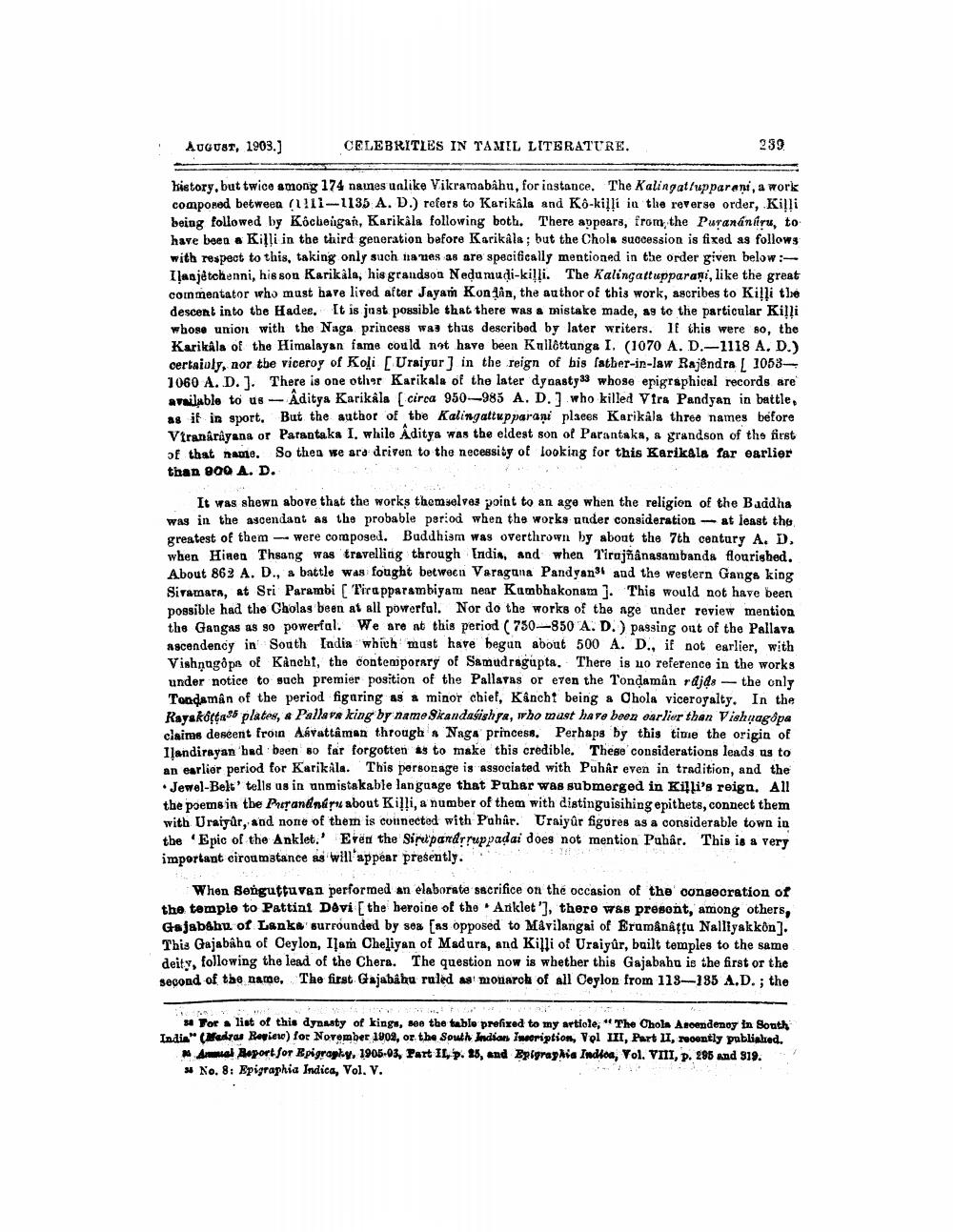________________
AUGUST, 1903.)
CELEBRITIES IN TAMIL LITERATURE.
239
history, but twice among 174 names unlike Vikramabahu, for instance. The Kalingat/upparani, a work comporod between (1111-1135 A. D.) refers to Karikala and Ko-kisli in the reverse order, Killi being followed by Kocbongan, Karikala following both. There appears, from the Purananitru, to have been a Killi in the third generation before Karikala; but the Chola succession is fixed as follows with respect to this, taking only such naues as are specifically mentioned in the order given below: Ilanjètchenni, his son Karikala, his grandson Nedumudi-killi. The Kalingattupparaại, like the great cornmentator who must have lived after Jayan Kontàn, the author of this work, ascribes to Killi the descent into the Hades. It is just possible that there was a mistake made, a9 to the particular Killi whose union with the Naga princess was thus described by later writers. If this were so, the Karikala of the Himalayan fame could not have been Kullottunga I. (1070 A.D.-1118 A, D.) certainly, nor tbe viceroy of Koli [Uraiyur] in the reign of bis father-in-law Rajendra [ 10534 1060 A.D.). There is one other Karikala of the later dynasty 33 whose epigraphical records are available to us --Aditya Karikala (circa 950-985 A. D.] who killed Vira Pandyan in battle. as it in sport. But the author of the Kalingattupparani plaees Karikala three names before Vtrankriyana or Parantaka I. while Aditya was the eldest son of Parantaks, & grandson of the first of that namo. So then we are driven to the necessity of looking for this Karikala far earlier than 900 A. D.
It was shewn above that the works themselves point to an age when the religion of the Baddha was in the ascendant as the probable period when the works under consideration - at least the greatest of them were composed. Buddhism was overthrown by about the 7th century A. D. when Hinen Thsang was travelling through Indis, and when Tirajñanasambands flourished. About 862 A. D., a battle was fought between Varagana Pandyan and the western Ganga king Sivamara, at Sri Parambi ( Tirapparambiyam near Kumbhakonam). This would not have been possible had the Cholas been at all powerful. Nor do the works of the age under review mention the Gangas as so powerful. We are at this period (750-850 A.D.) passing out of the Pallava ascendency in South India which must have begun about 500 A. D., if not earlier, with Vishnugopa of Kancht, the contemporary of Samudragupta. There is no reference in the works under notice to such premier position of the Pallayas or even the Tondamân rdjas - the only Tondemân of the period figaring as a minor chief, Kâncht being a Chola viceroyalty. In the Rsyskocta85 plates, « Pallavs king by name Skandasishya, who must have been earlier than Vishwagopa claims deseent froin Asvattaman through Nage princess. Perhaps by this time the origin of Ilandirayan had been so far forgotten is to make this credible. These considerations leads us to an earlier period for Karikala. This personage is associated with Puhâr even in tradition, and the
Jewel-Belt' tells us in unmistakable language that Puhar was submerged in Killi's reign. All the poems in the Pherandneu about Killi, a number of them with distinguisihing epithets, connect them with Uraiyar, and none of them is connected with Pahûr. Uraiyar figures as a considerable town in the Epic of the Anklet. Even the Siredpandyruppadai does not mention Puhâr. This is a very important circumstance as will appear presently.
When Senguttuvan performed an elaborate sacrifice on the occasion of the consecration of the temple to Pattiai Devi (the heroine of the Ariklet '], there was present, among others, Gajabahu of Lanks surrounded by sea (as opposed to Mávilangai of Eromânâţgu Nalliyakkön). This Gajabâha of Ceylon, Ilar Cheliyan of Madura, and Killi of Uraigûr, built temples to the same deity, following the lead of the Chora. The question now is whether this Gajababu is the first or the second of the name. The first Gajabahu ruled as monarch of all Ceylon from 118-185 A.D.; the
Tor list of this dynasty of kings, see the table prefixed to my artiole, "The Chola Ascendency in South India" (Madras Review) for November 1902, or the South Indians incription, Vol III, Part II, 2e0ently publialued.
Amal Raport for Epigraphy, 1906-03, Part IL, p. 15, and Epigraphia India, Vol. VIII, P. 295 and 319. No. 8: Epigraphia Indica, Vol. V.




